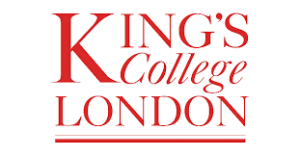Published on April 28, 2023
Reading Time: 14 min
UCAT Abstract Reasoning Tips, Questions & Strategies
The abstract reasoning section of the UCAT can be daunting for many students at first. This article will help you understand what UCAT Abstract Reasoning is and how to practice answering Abstract Reasoning questions, along with some useful tips on being successful in this section of the UCAT.
What is UCAT Abstract Reasoning?
Abstract Reasoning is the fourth section of the UCAT, it comes before the situational judgement test section and after the quantitative reasoning section. Although students find this section to be particularly difficult at first, the questions tend to get easier with practice. The majority of Abstract Reasoning questions are in sets of 5, while some are standalone questions. Each question is independent of other questions and is associated with the pattern provided. This article will help you understand what UCAT Abstract Reasoning is and how to practice answering Abstract Reasoning questions, along with some useful tips on being successful in this section of the UCAT.
The Abstract Reasoning subtest assesses your ability to scrutinise patterns, deduce relationships from abstract figures, derive hypotheses, and to predict the next sequence in a pattern. The data within the questions presents in the form of abstract shapes, patterns, and designs.
UCAT Abstract Reasoning Time
The UCAT Abstract Reasoning section consists of 50 questions that are to be completed in 12 minutes. This gives roughly 14 seconds per question.
UCAT Abstract Reasoning Average Score
Abstract Reasoning had the highest average of the UCAT sections in 2022, with the average being 659. Since 2018, the sections with the highest average score on the UCAT have been either Abstract Reasoning or Quantitative Reasoning. The average UCAT Abstract Reasoning score has been between 637-659 each year since 2018.
What is a Good Score for Abstract Reasoning for UCAT?
A ‘good’ score for Abstract Reasoning for UCAT would be a score that is above the average for your testing cycle. Universities typically focus on your overall average UCAT score for admissions purposes. Our free resource has the most up-to-date UCAT scores needed for medicine for each university in 2023. Check out ‘Master the UCAT by the Top 1%‘, our #1 Amazon Bestselling UCAT book to learn all the tips and tricks necessary for improving your score and achieving 800+ on Abstract Reasoning!
Types of UCAT Abstract Reasoning Questions
There are 4 types of Abstract Reasoning questions in the UCAT:
| Question Type | Time Needed | Description |
| Type 1 | ~70 seconds | There are 2 sets of shapes given (Set A and Set B), each with 6 boxes representing the same pattern. 5 associated questions each show 1 box. You must decide whether the box demonstrates the same pattern as Set A or Set B. |
| Type 2 | ~10-15 seconds | There is a specific change that is applied to a series of boxes that contain shapes. You must identify the change in order to select the next box in the series. |
| Type 3 | ~20 seconds | A specific change is made to one box. You must identify the change and apply it to another box. |
| Type 4 | ~70 seconds | Similar to Type 1 questions. Rather than 5 questions with 1 box each, you are given 5 questions with 4 boxes each, and you must identify which box in each of the questions belongs to either Set A or Set B. |
UCAT Abstract Reasoning Type 1 Questions
Type 1 questions require you to analyse two sets (A and B) which each contain 6 boxes of shapes. The Abstract Reasoning pattern in one set will apply to each of the boxes in the set and will be unlike the pattern in the other set. Once you identify the pattern, you can answer each of the 5 associated questions – simply determining whether each test shape given holds the same pattern as set A or set B.
Note: For the correct answer to be Set A, the test shape in the question cannot also apply to Set B, and vice versa. If it happens to apply to both, you are either missing one of the patterns, or you must say that it applies to neither.
UCAT Abstract Reasoning Example Questions – Type 1
Try out the example question below, which is taken as an excerpt from our #1 Amazon Best Selling book ‘Master the UCAT by the Top 1%‘.
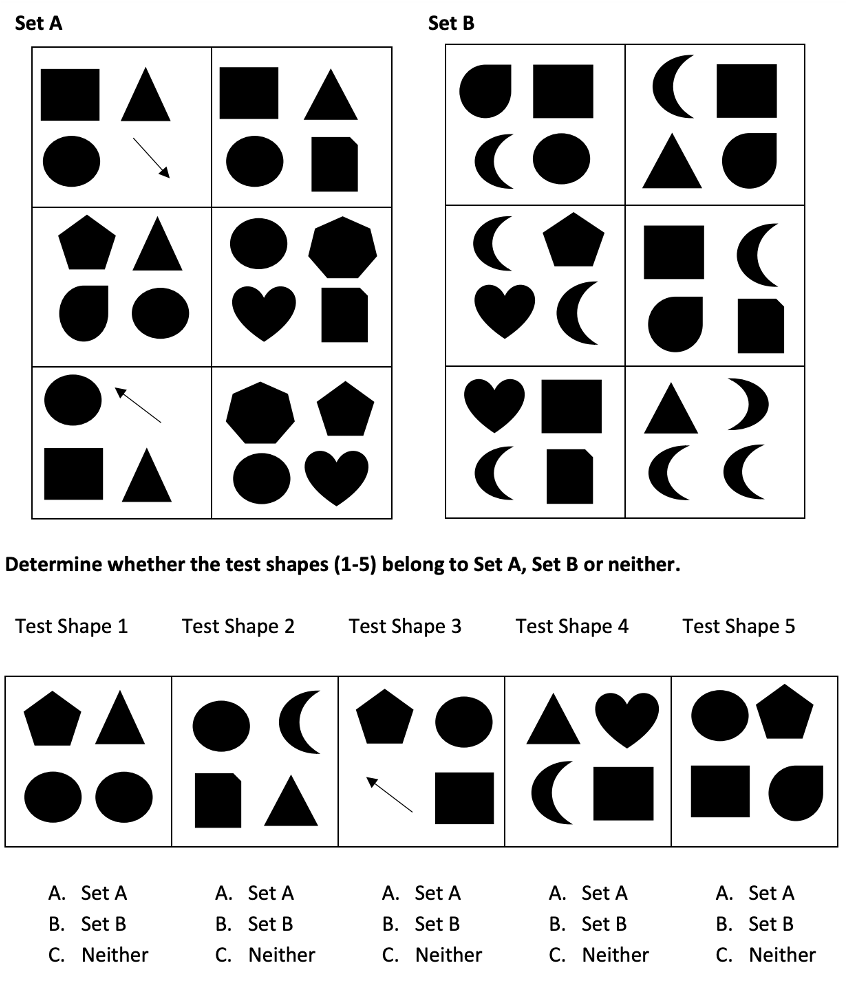
Answers:
- The correct answer is C. Each of the 4 shapes has an odd number of sides, therefore, it does not fit into either Set A or Set B.
- The correct answer is A. 3 shapes have an odd number of sides, while the crescent moon has an even number of sides.
- The correct answer is A. The square has an even number of sides, while the other 3 shapes have an odd number of sides.
- The correct answer is B. There are 3 shapes with an even number of sides, and the triangle has an odd number of sides.
- The correct answer is C. You can see that the circle and the pentagon have an odd number of sides, while the square and the leaf have an even number of sides. This does not fit in with any of the patterns.
Type 1 Questions Strategy
When you first look at a pattern, you should always do so from a slight distance. Move your head back and take a quick overall glance at both sets to see whether anything obvious stands out. This makes much more sense when your brain is trained to recognise patterns, so you are unlikely to be able to apply this “quick glance” method when you are just starting your revision, however, can develop this skill with time and practice.
If you see nothing at a quick glance, move on to the simplest box rule.
- Locate the simplest box. This can be something that has the least number of shapes, the least number of lines, the least number of colours, the least variety, or whatever looks simplest to you.
- The simplest box can be in either Set A or Set B, or both may have an equally simple box. It does not matter which set you look at first, as you will have to determine the pattern in the other set regardless.
- If you feel like you may recognise a pattern within the simplest box you have chosen, look at the next simplest box to test your theory. The pattern must apply to every single box in the set in order to be valid, therefore, if it does not apply, you must try again.
- If you cannot see any pattern in the simplest box, compare the two simplest boxes and see whether there is a similarity between the two.
- Note: If you are short on time, see if the pattern applies to at least 3 of the boxes, rather than going through all of them. If it does apply to at least 3, there is a good chance that you have discovered the pattern.
If you find this useful, it’s an excerpt from our popular UCAT content, created by the top 1% scoring candidates! Check out the best UCAT resources, such as our 2-day live UCAT course, online UCAT course (175 lessons), UCAT book, and one-to-one UCAT tutoring for more UCAT support.
SCANOS / SCANS
You can use the below method to help identify the pattern in an Abstract Reasoning set.
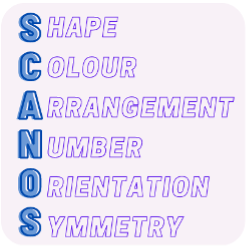
Below are some questions you can ask yourself for each of the points within SCANOS.
Shape:
- Is there a specific shape present in each box?
- Are two shapes always present together?
- Is there a particular stand-out rule that applies to each of the shapes present in each of the boxes in a particular set?
- What type of triangle is present?
- Is there any irregularity in the shapes?
- Are there different sizes of shapes?
Colour:
- Is there a specific colour allocated to a shape?
- Does the colour of a shape influence its size?
- Does a specific colour correlate to the number of sides in a shape?
- Are there a certain number or ratio of coloured shapes to uncoloured shapes?
- Is there a relationship between the shape of an object, and where an arrow or a triangle in the box is pointing?
Arrangement:
- Is a specific shape always located in a specific place?
- Is the arrangement of a shape relative to another shape?
- Is the arrangement of a shape dependent on any other factor?
Number:
- Are there a fixed number of shapes of a particular kind within every box?
- Do the shapes in each box have a total number of sides that is present in all of the boxes?
- Does each box contain a specific number of a certain angle?
- Are there a specific number of diagonals, corners, or anything else in each box?
- Is there a pattern based on multiples of a number?
- Is there a different numerical pattern I have not yet spotted?
Orientation:
- Do all of the arrows point towards a particular direction?
- Does the orientation of a shape depend on any numerical factor?
- Are certain shapes rotated by a particular angle, respective to the other shapes?
- Is there a ratio between the number of times a shape is orientated in one direction and the number of times it is orientated in another direction?
- Are the number of shapes pointing in one direction greater or less than the number of shapes pointing in another direction?
- Is one orientation of a particular shape relative to its other orientation(s)?
Symmetry:
- Do all the shapes within a box possess either bilateral or rotational symmetry?
- Does one set only have symmetrical objects?
- Is the symmetry of objects dependent on the presence of other factors?
- Is the entire box symmetrical, rather than each shape?
Speak to an admissions expert today!
UCAT Abstract Reasoning Type 2 Questions (Series)
The majority of questions in Abstract Reasoning are Type 1 – an example being the previous question shown. Type 2 questions will always make their appearance in the UCAT, but far less frequently than the first type. In this question type, you will be given a series of shapes, normally 3 or 4, and will be required to assess the sequence of changes, or the differences between the shapes, rather than the similarities. This will allow you to decipher which shape is next in the series by applying the pattern rules demonstrated.
Each Abstract Reasoning Type 2 question is only worth 1 mark, compared to Type 1 questions that have 5 marks each, therefore you should spend far less time on this type of question – ideally, no more than 15 seconds. The strict time limit makes these questions much more difficult, although given endless time to solve, they are not too tricky.
A very straight-forward UCAT Abstract Reasoning example question is shown below. See if you can identify the pattern, then answer the practice question.

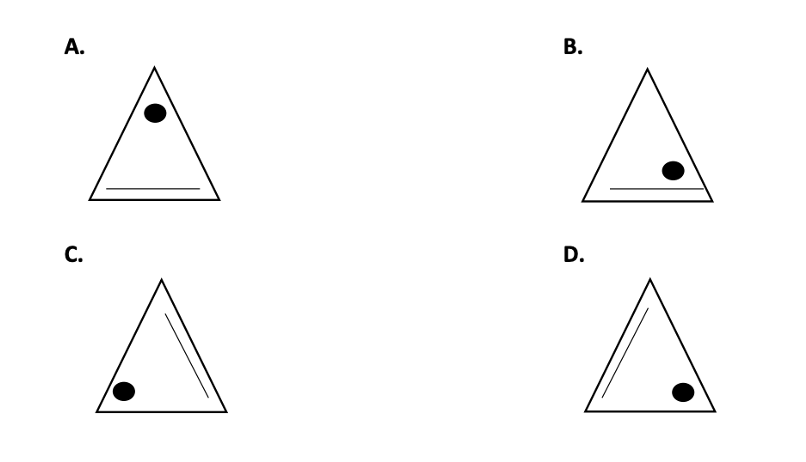
The correct answer is A.
The circle moves one place in an anti-clockwise direction with each subsequent shape in the series. The line also follows the exact same pattern.
Abstract Reasoning Type 2 Questions Strategy
One of the strategies you can use for this type of Abstract Reasoning question is the Conveyer Belt Strategy. To identify the pattern, follow these steps:
- Look at the overall picture and determine what appears to be changing – whether there is some sort of movement, change in colour, change in size, change in number, etc.
- Start with the first and second stages of the conveyer belt, or the second and third, or third and fourth.
- You cannot skip stages and look at the second and fourth, for example. Each stage occurs in sequence to the last, so you will be unable to identify the pattern if you skip stages.
- Select one shape or aspect (that you determined in step 1) that changes between the two stages you are comparing. Identify the pattern of change.
- Usually, there is not only one thing that is changing. You should not try to look at everything that changes all at once. If you select only one aspect, it will be much easier to answer the question. Sometimes, there is only one pattern (although multiple changes may be present as distractors, or may be following the same pattern), so it is not worth your limited 15 seconds to continue to assess for further patterns unless you are unable to decide on an answer with the first pattern alone.
- Move on to the next stage in the Abstract Reasoning sequence. Does the pattern hold? Or is it slightly different than you thought?
- Compare the final stage. Confirm that the pattern holds true.
- Look at the answer options and eliminate any answer that does not satisfy the pattern. If there is only one option left, great! You have the answer. If there are multiple options left, there must be another pattern.
- In this case, follow steps 1-5 for a different shape or aspect that changes between the stages, eliminating any answer that does not follow the pattern of change. You should have your answer after two patterns. If you do not, simply guess the answer from the remaining options, as you cannot afford to spend much longer on this question type – it is only worth 1 mark out of 55, and the entire UCAT Abstract Reasoning subtest is only 13 minutes long!
Are you finding this useful? It’s an excerpt from our popular UCAT content, created by top 1% scoring candidates! Check out the best UCAT resources, such as our 2-day live UCAT course, online UCAT course (175 lessons), UCAT book, and one-to-one UCAT tutoring for more UCAT support.
UCAT Abstract Reasoning Type 3 Questions (Relationships)
This is another type of UCAT Abstract Reasoning question that makes a minimal number of appearances, but will undoubtedly come up. You are presented with an image on the left which is directly related to an image on its right, connected by the words “is to”. There is then a second image on the bottom left, and you must apply the pattern that links the top two images together in order to determine the image that will appear on the bottom right. You have roughly 15 seconds, as there is only one mark for this type of question in the UCAT. An example question for this is shown below.
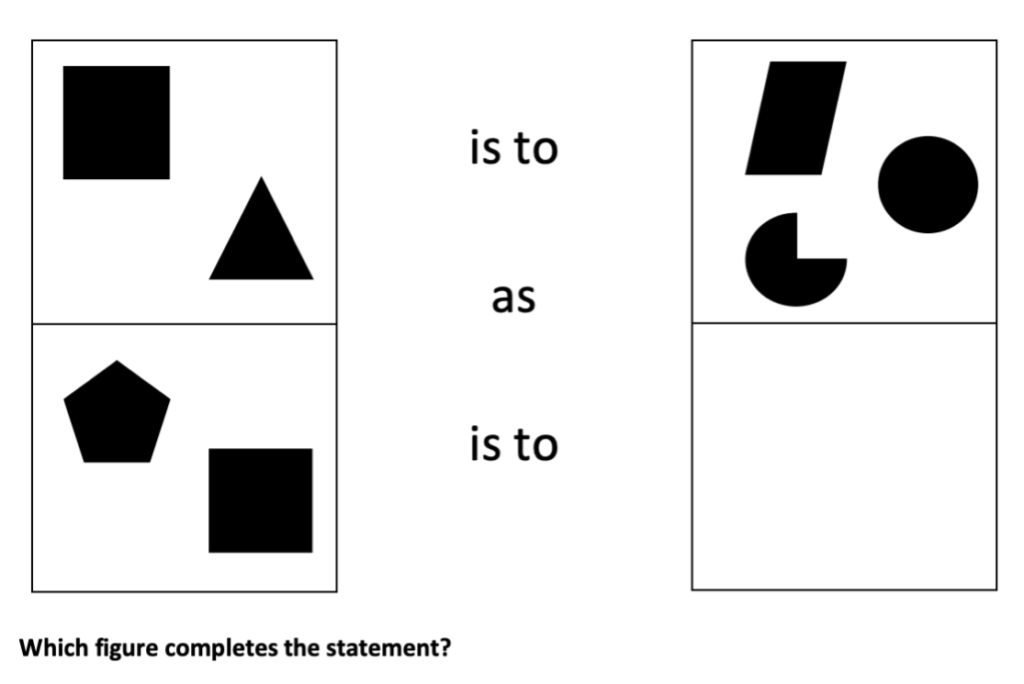
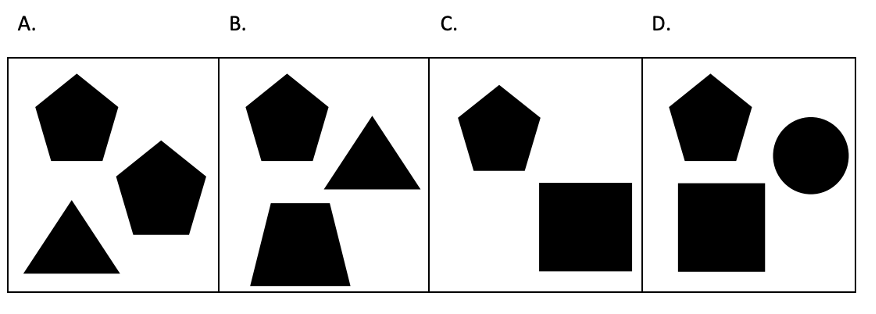
The correct answer is D. See the strategy below to understand how we can determine this.
Abstract Reasoning Type 3 Questions Strategy
This Abstract Reasoning question type is similar to Type 2, as you must identify the pattern behind the “change” that occurs from left side to right side, and apply that pattern to determine your answer. The strategy you can utilise is as follows:
- Take a glance at both sides to see if there is any obvious change you notice – look out for all of the characteristics you have learned, such as size, shape, number, colour, etc.
- Select one aspect that appears to be changing and verify the change between the boxes. Identify any further characteristics of the change.
- Apply that change to the box underneath, using the answer options to confirm. If the same pattern that you have identified in the top column is applicable to any of the answer options that fit into the bottom column, that is your answer.
- If you are unable to select an answer based on this single pattern, you can:
- Assess which aspects have not changed between the boxes, i.e. the immobile aspects. If this immobile aspect happens to change in any of the answer options, you can immediately eliminate it. For example, if there is no change in colour between the boxes, but one of the answer options has a change of colour, that option is immediately eliminated.
- Assess for a second pattern.
Using the strategy above, at a quick glance, we can see the following features:
- Change in number of shapes.
- Change in the types of shapes, so there is a likely change in the total number of lines/sides.
- No change in colour, symmetry, size, arrangement, or orientation.
Let us focus on one of these aspects: number of shapes. This is quick and easy to work with.
- There are 2 shapes in the first box and 3 shapes in the second. The box underneath also has 2 shapes, so its missing box should have 3 shapes. This immediately allows us to eliminate option C which only has 2 shapes.
- Note: This exact number does not have to follow! If the box underneath had 4 shapes, perhaps its missing box would have 5 (i.e. 5 is 1 more than 4, as 3 is 1 more than 2).
- We are unable to decide between options A, B and D based on number of shapes alone, so we need to identify another pattern. Count the number of sides – there are 7 sides in the first box and 8 sides in the second. 8 is 1 more than 7, so we would expect the bottom column to also hold this same pattern. The pattern underneath has 9 sides in total, so the missing box should have 10 sides. Rather than counting all of the sides in each of A, B and D, look to see if there is anything obvious. Option D has the exact same shapes, with an additional circle. We know that a circle has 1 side, so we can safely select this option.
UCAT Abstract Reasoning Type 4 Questions (Set Selection)
This question type is very similar to Type 1 Abstract Reasoning questions. However, you will not be asked to decide between Set A and Set B for each of 5 given boxes. Instead, you will be given Set A and Set B, followed by a series of 5 questions that each have 4 boxes to choose from. In each of the questions, you will be asked one of the following:
- Which of the following test shapes belongs in Set A?
- Which of the following test shapes belongs in Set B?
Please see the example below.
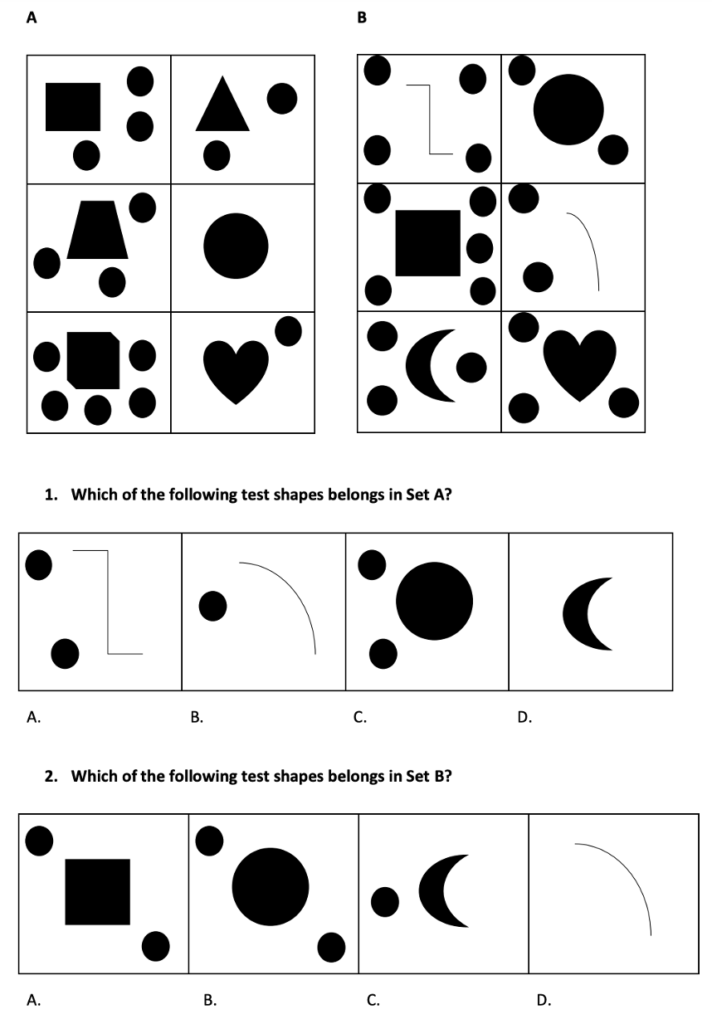
Answers:
- The correct answer is A. The large shape has 3 sides, and there are 2 small circles present.
- The correct answer is B. The large shape has 1 side, and there are 2 small circles.
Abstract Reasoning Type 4 Questions Strategy
The same basic strategy applies as for Type 1 questions.
- Move your head back and get a good overall view of the two sets.
- If you are unable to see a pattern, select the simplest box and follow the simplest box strategy.
- Answer each of the questions. There is only one correct answer, so when you find it, do not check any more of the boxes – you will be wasting precious seconds!
Are you finding this useful? It’s an excerpt from our popular UCAT content, created by top 1% scoring candidates! Check out the best UCAT resources, such as our 2-day live UCAT course, online UCAT course (175 lessons), UCAT book, and one-to-one UCAT tutoring for more UCAT support.
UCAT Abstract Reasoning Tips
Time Your Questions
Abstract Reasoning is hard to being with. You can start your UCAT practice untimed to give yourself a chance to work through all of the strategies and identify the relevant Abstract Reasoning patterns. Once you become more comfortable with pattern recognition, you can start doing questions in timed conditions. However, do not spend too long in the untimed stage, as you need to push your brain to identify patterns quickly.
Create a Pattern Bank
When you do UCAT Abstract Reasoning practice questions, keep a notebook and write down every pattern that comes up. You should build a bank of patterns throughout your weeks of UCAT revision. Whenever you are stuck on an Abstract Reasoning question, you can refer to the bank to determine whether any of the patterns you’ve written down might fit. If not, then add the new one to your bank once you figure out the answer. If you do thousands of questions, you will find that the same 60 or so patterns are repeated throughout! So, the more you do, the easier it will get, as you will begin to recognise the patterns that appear.
Recognise Distractors
Make a note of all of the distractors that appear in your Abstract Reasoning practice questions. This will allow you to recognise distractors in future patterns to increase your efficiency at pattern recognition.
Create a Reference Point During Your UCAT Exam
On your UCAT exam day, in the minute before the Abstract Reasoning section, try to write down as many patterns as you can remember. This will help jog your memory and provide you with a reference point if you are stuck during the test. To prepare for this minute, practice writing out the patterns you can remember in the minute before your UCAT mock tests at home.
Learn to Discard
Do not waste your time on the hardest questions. As with every section, the question writers like to waste your time with extremely difficult Abstract Reasoning questions. Often, when the beginning questions are difficult, students are afraid to flag as they have not yet answered anything. However, these questions are there on purpose to waste your time! Do not be afraid to guess and flag.
Allow Room for Improvement
Don’t worry if you are struggling with identifying patterns. There are a lot of very challenging and time-consuming patterns in Abstract Reasoning. In the beginning weeks of your Abstract Reasoning revision, you are not expected to be able to identify all of these within a number of seconds. Allow yourself room for improvement over the weeks, and hopefully the more difficult patterns will get easier for you. On average, students see the biggest improvement in Abstract Reasoning from their initial UCAT mock test to their final UCAT score.
We hope this article was useful for your UCAT preparation! It’s an excerpt from our popular UCAT resources, created by top 1% scoring candidates!














